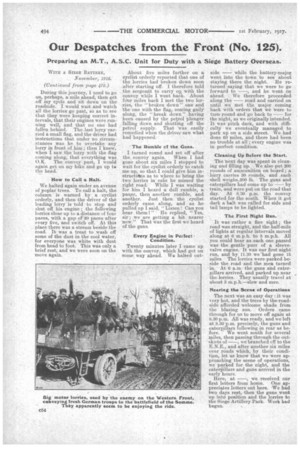Our Despatches from the Front (No. 125).
Page 20

If you've noticed an error in this article please click here to report it so we can fix it.
Preparing an ACT., A.S.C. Unit for Duty with a Siege Battery Overseas.
WITH A SIEGE BATTERY,
November, 1916.
(Continued from rage 470.) During this. journey, I used to go on, perhaps, a mile ahead, then get .off my cycle and sit down on the roadside. I would wait and watch all the lorries go past, so as to see that they were keeping correct intervals, that their engines were running well), and that no one had fallen behind. The last lorry carried a small flag, and the drier had instructions that under no circumstances was he to overtake any lorry in front of him ; then I-knew, when I saw. the lorry with the .flag coming along, that everything was O.K. The convoy past, I would again get on my 'bike and go up to the head.
How to Call a Halt.
We halted again under an avenue of poplar trees. To call a halt, the column is . warned by a cyclist orderly, and then the driver of the leading lorry is told • to stop and shut off his engine ; the following lorries close up to a distance of four paces, with a gap of 20 paces after every five, and switeh off. At this place there Was a stream beside the road. It was a treat to wash off some of the dust in the cool water, for everyone was white with dust from head to foot. This was only a brief rest, and we were soon on the move again. About five miles further on a cyclist orderly reported that one of the lorries had broken down soon after starting off. I therefore told the sergeafit to carry oa with the convoy while I went back. About faur miles back I met the two lor:ries, the " broken down" one and the one with the flag, coming gaily along, the " break down" having been caused by the pqrol plunger falling down and shutting off the petrol supply. That was easily remedied when the driver saw what had happened.
The Rumble ci the Guns.
I turned round and set off after the convoy again. When I had gone about six miles I stopped to wait for the cyclist orderly to catch me up, so that I could give him instructiins as to where to bring the two lorries in cake he missed the right road: While I was waiting for him I heard a dull rumble, a pau,se, then another rumble, and another. Just then the cyclist orderly came along, and as he pulled up I said, " Listen ! Can you hear them'? " He replied, "Yes, sir ; we are getting a bit nearer now." That was the first we heard of the guns.
• Every Engine in Pei feet Condition.
Twenty minutes later I came up with the convoy, which had got on some way ahead. Wo halted out side — while the battery-major went into the town to see about staying there the night. He returned saying that we were to go forward to —, and he went on ahead. We therefore proceeded along the — road and carried on until we met the major coming back with orders that we were to turn round and go back to — for the night, as we originally intended. It was pitch dark, and with difficulty we eventually managed to park up on a side street. We had done 60 miles, and there had been no trouble at all ; every engine was in perfect condition.
Cleaning Up Before the Start.
The 'next day was spent in cleaning and filling up. We also put 200 rounds of ammunition on board ; a lorry, carries 30 rounds, and each shell weighs_200 lb. The guns and caterpillars had come up to — by train, and were put on the road that day. At 8.30 p.m. the convoy started for the south. When it got dark a halt was called for side and tail lamps to be lighted.
The First Night Run.
It was rather a fine sight ; the road w.as straight, and the half-mile of lights at regular intervals moved along at 6 .m.p.h. to 8 m.p.h. All you could hear as each one passed was the gentle purr of a sleevevalve engine. It was our first night run, and by 11.30 we had gone 15 miles. The lorries were parked beside the road and the men turned in. At 6 a.m. the guns and caterpillars arrived, and parked up near the lorries. . They usually travel at about 3 M.p.h.—slow and sure.
Nearing the Scene of Operations The next was an easy day : it was very hot, and the trees by the-roadside afforded welcome shade from the blazing sun. Orders came through for us to move off again at 8.30 p.m. All was ready, and we left at 8.30 p.m. precisely, the guns and caterpillars following in rear 9,8 before. We went south for several miles, then passing through the out
skirts of we branched off to the E.N.E., and after another six miles over roads which, by their condition, let us know that we were approaching the scene of operations, we parked for the night, and the caterpillars and guns arrived in the early hours.
Here, at —, we received our first letters from home. One appreciates letters out here. -We had two days rest, then the guns went up into position and the lorries to the Siege Artillery Park. Work had begun.
























